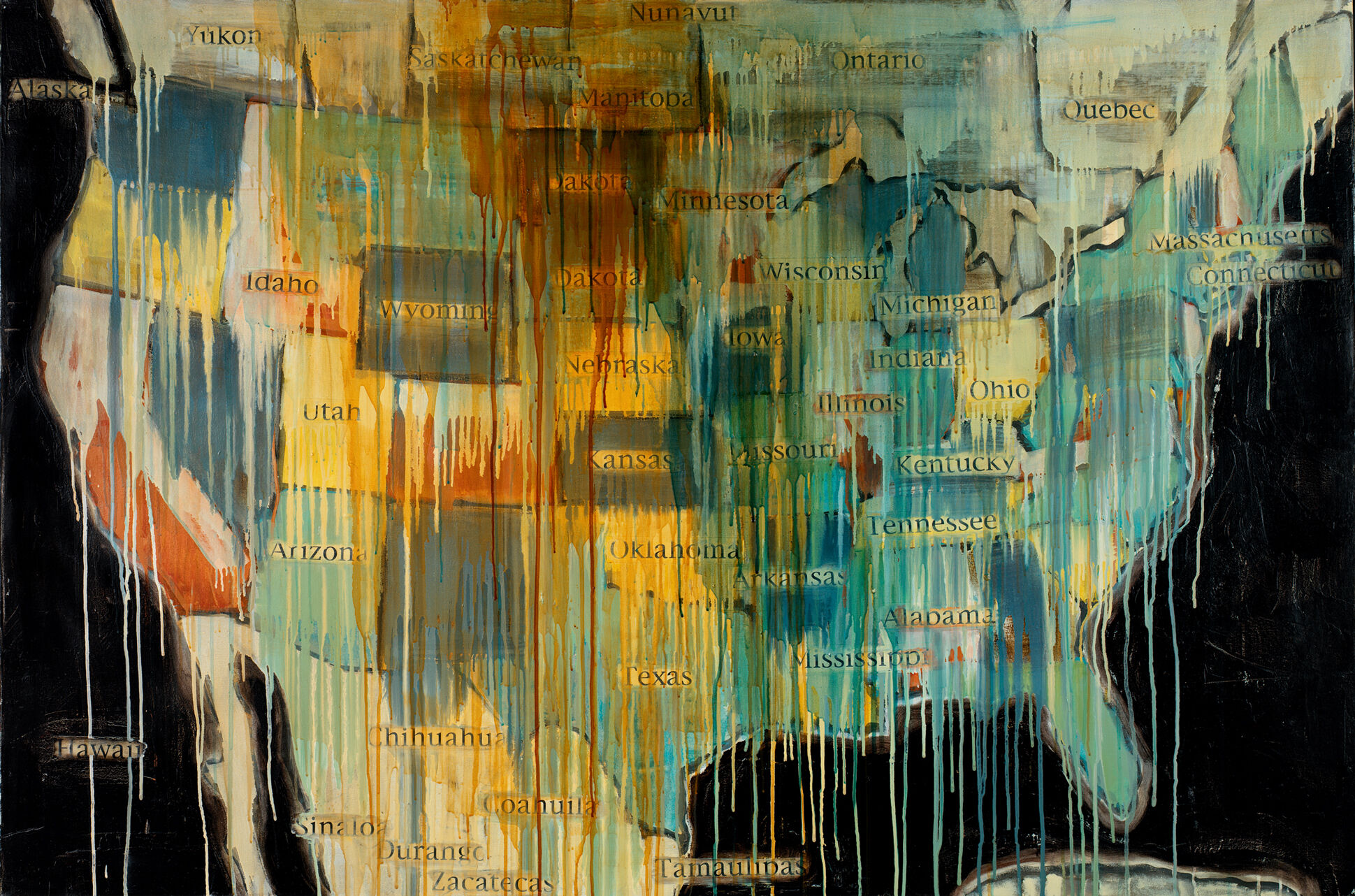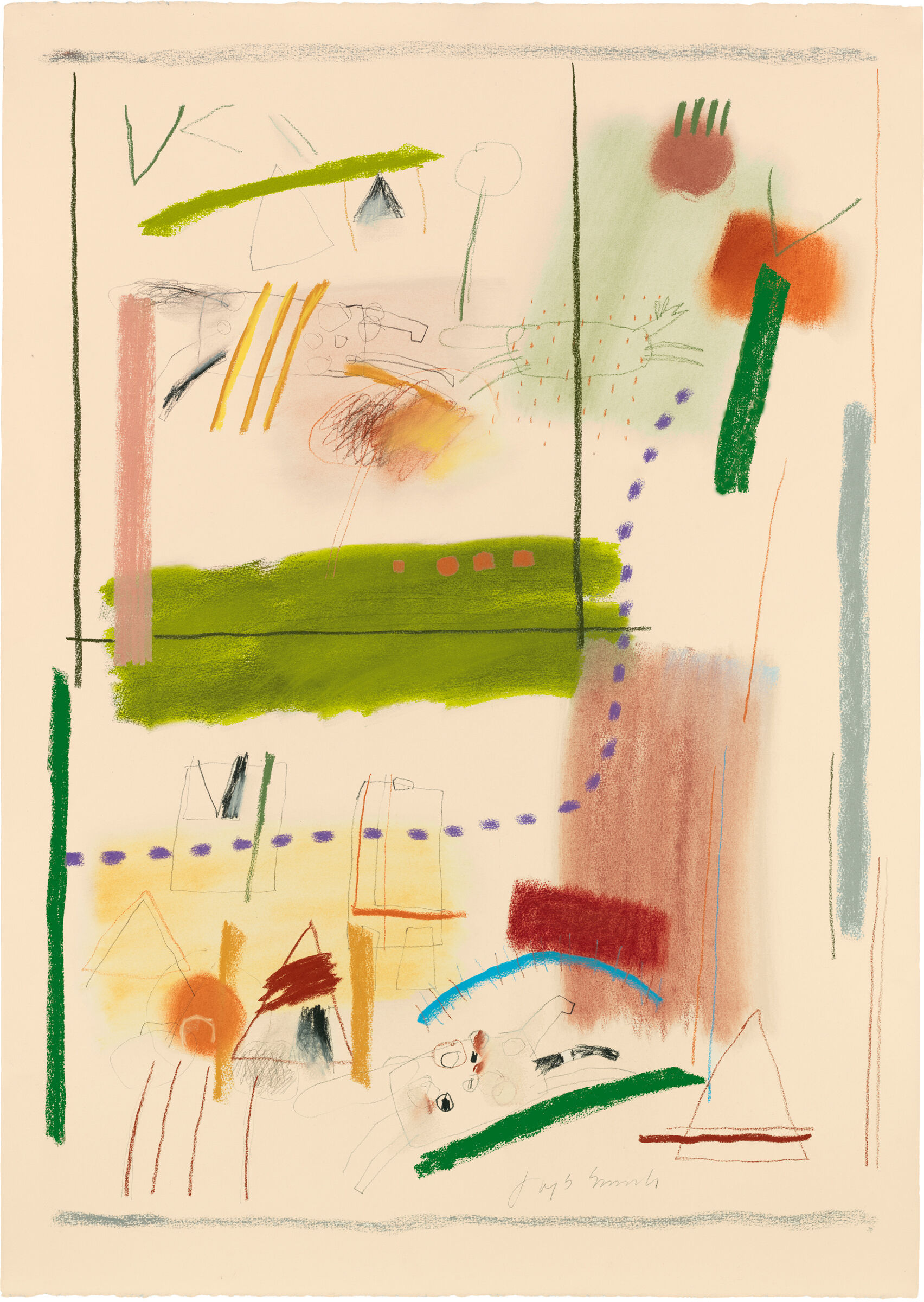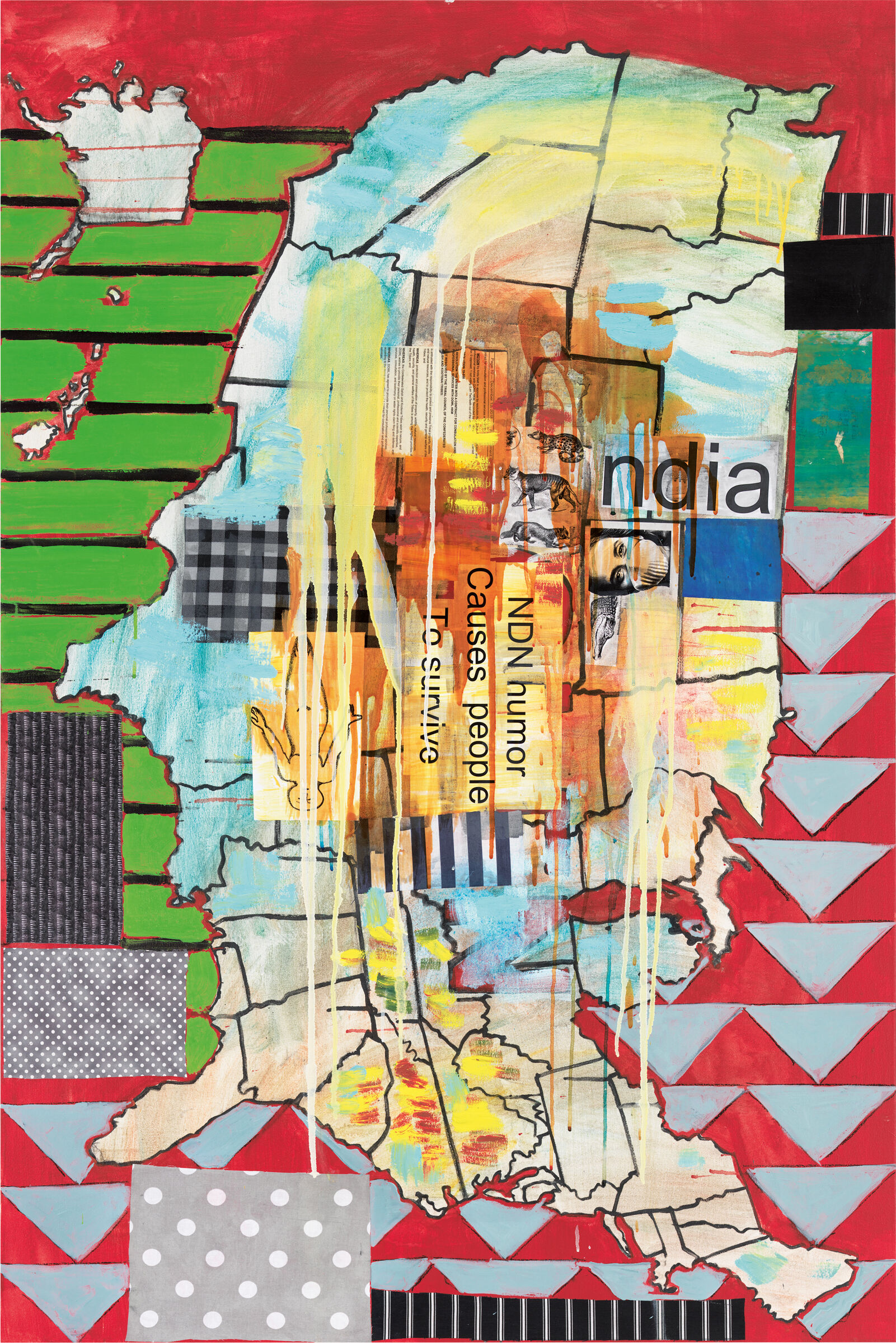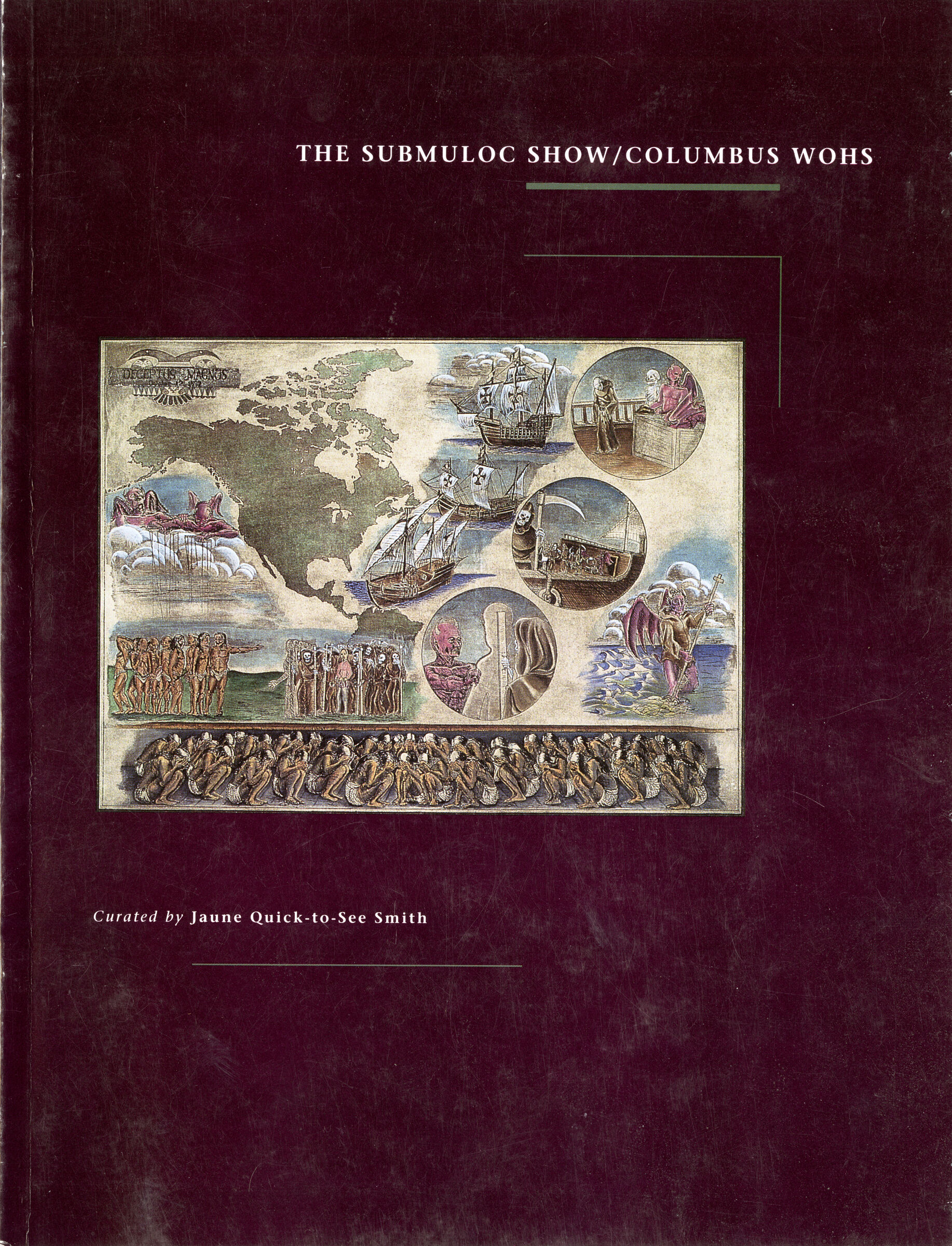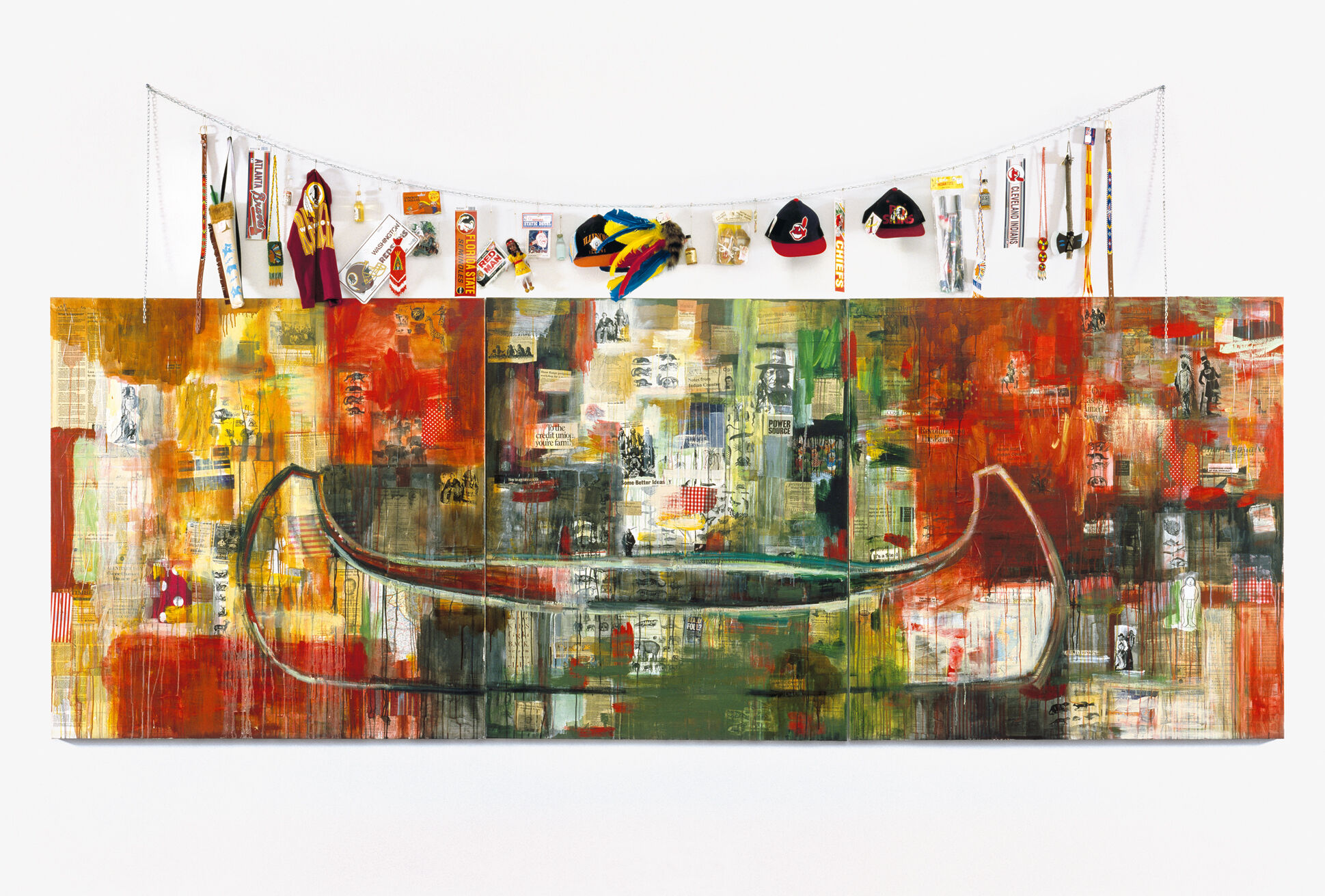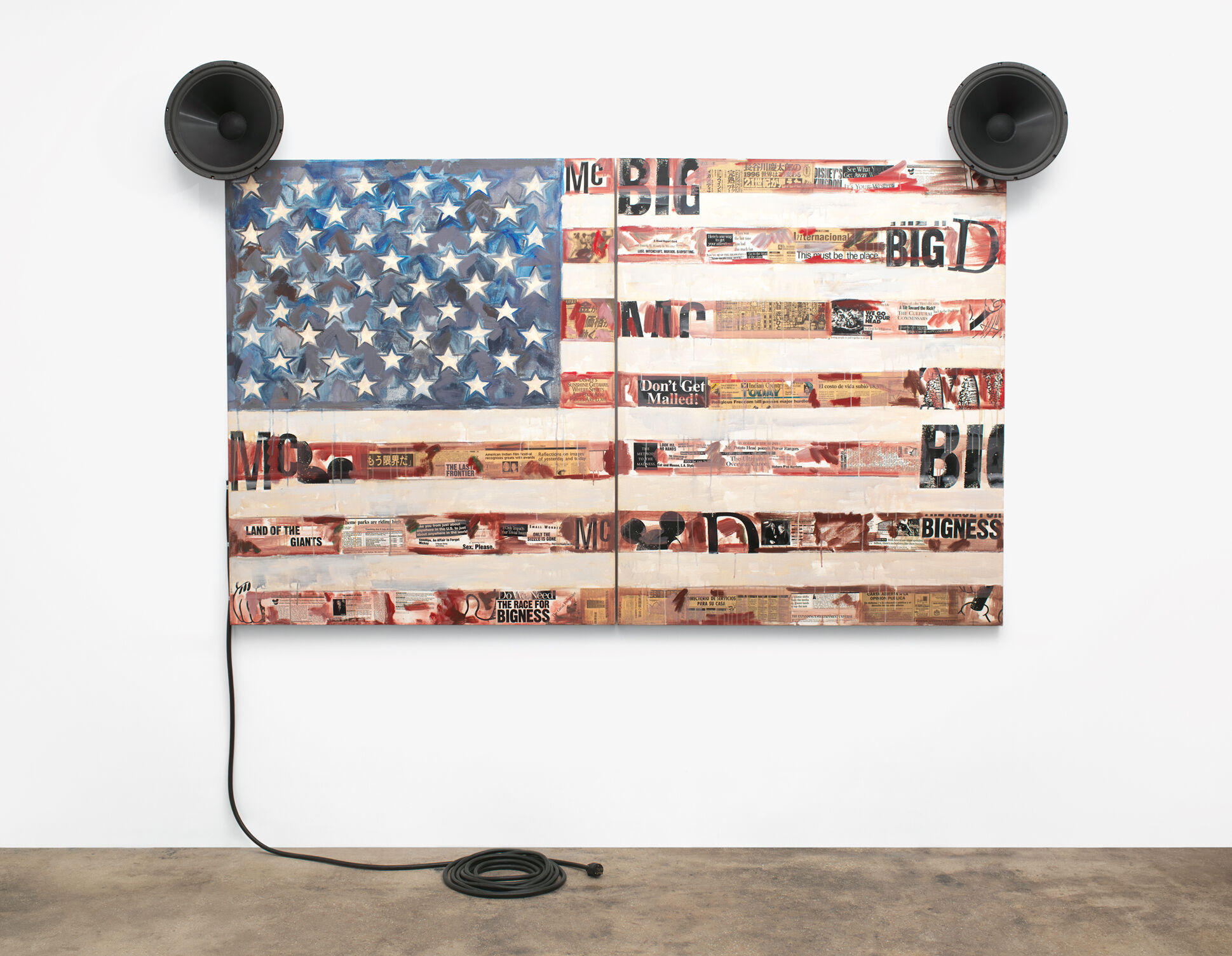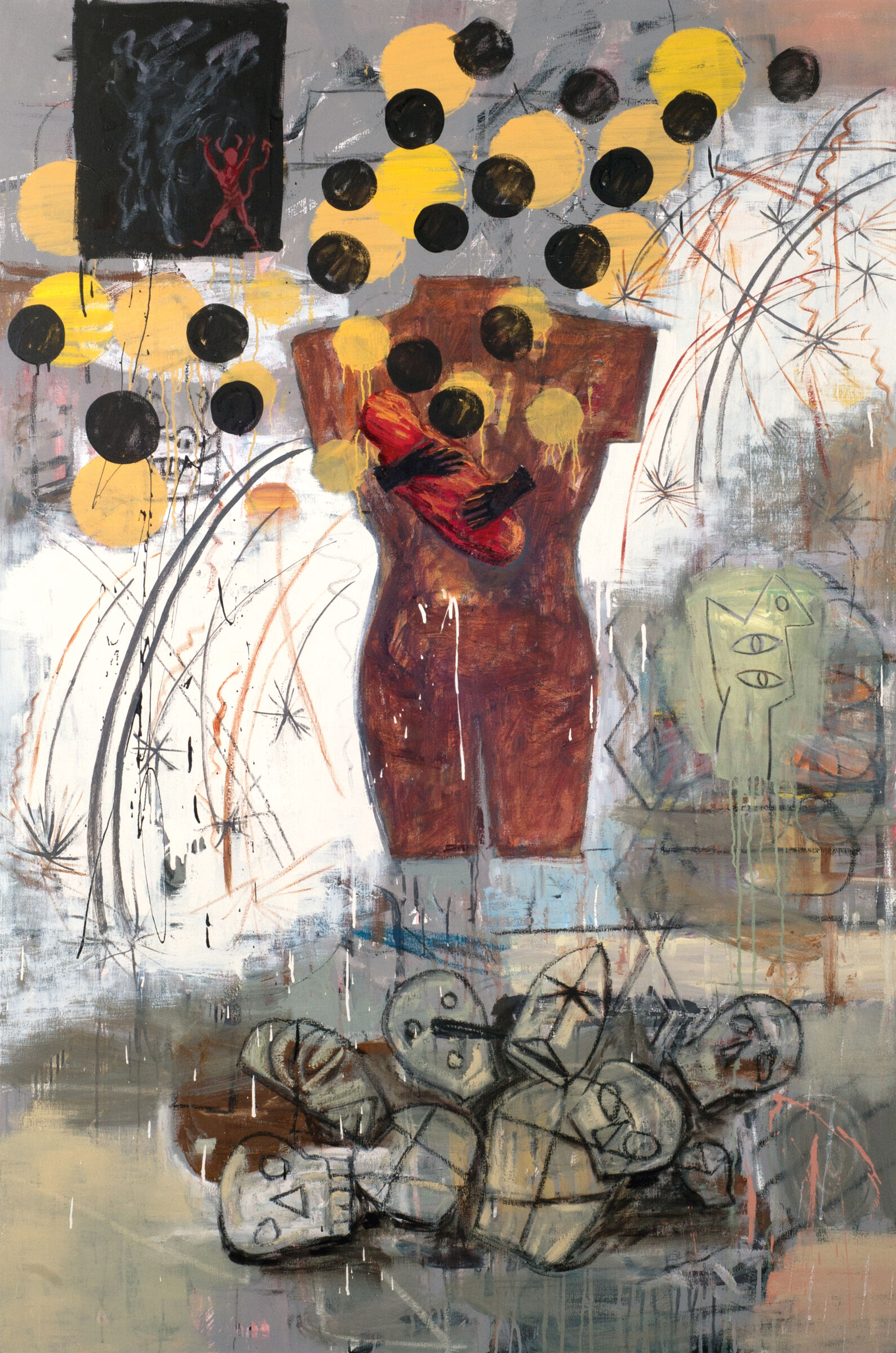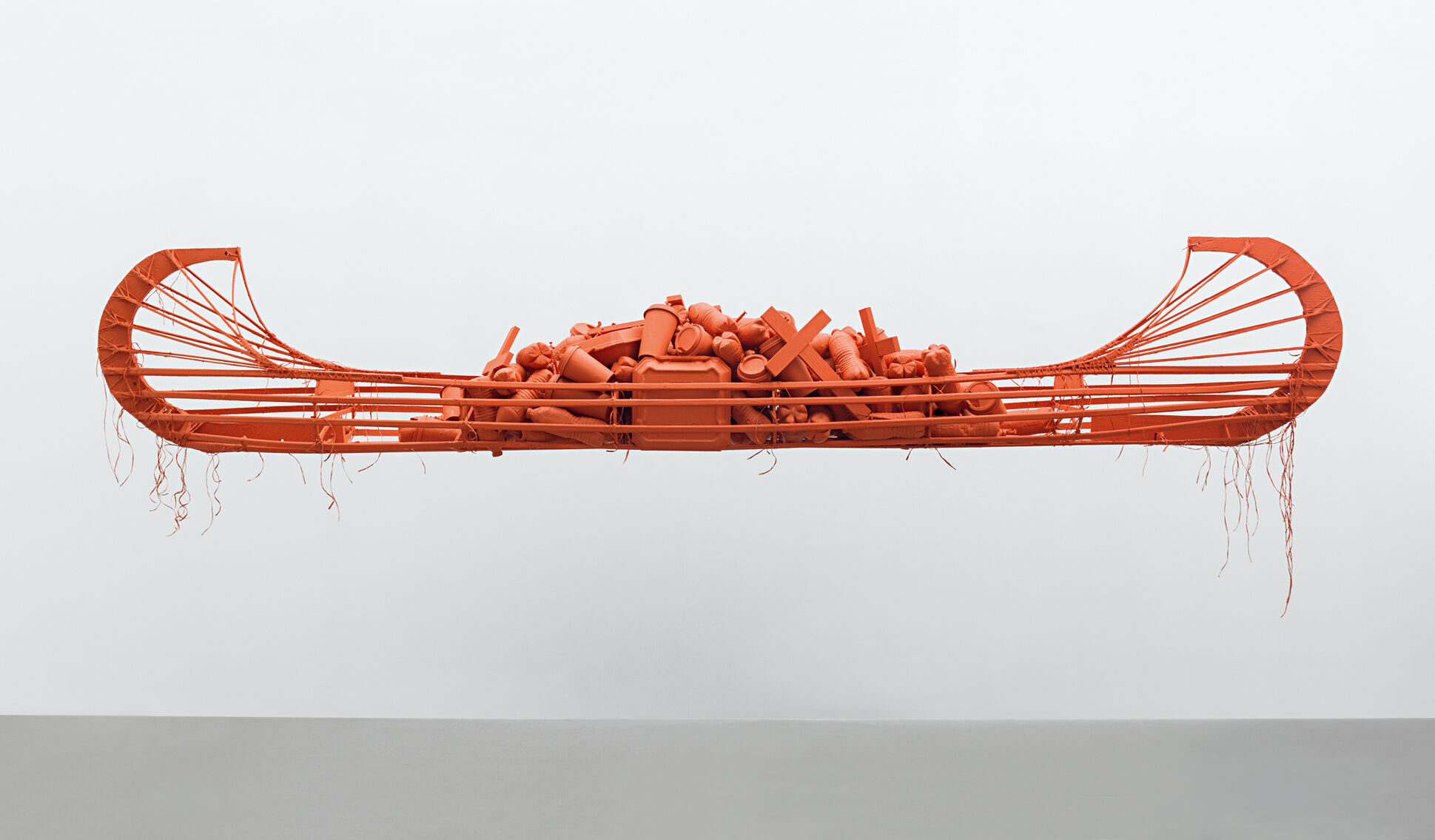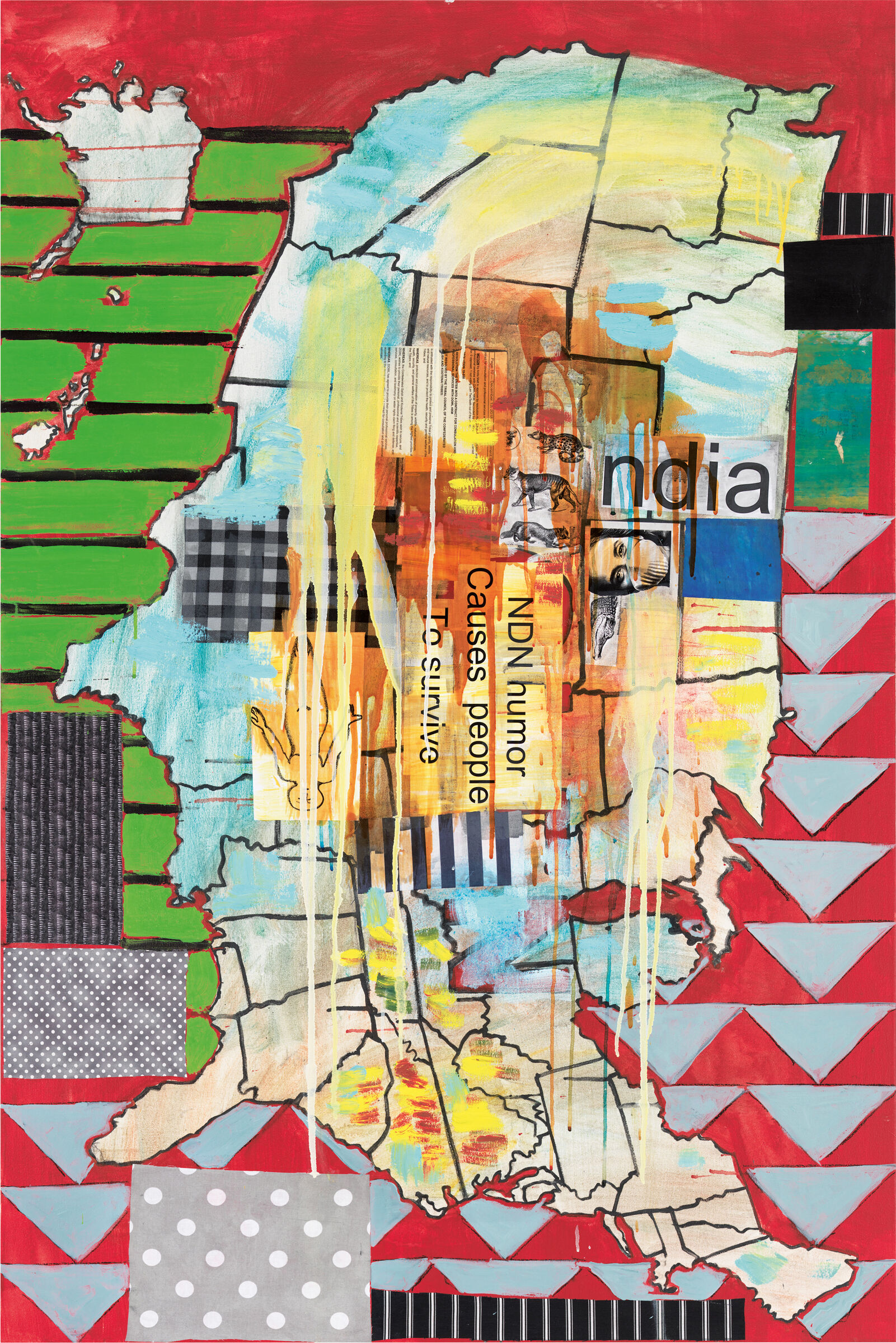“My Roots Extend”: Jaune Quick-to-See Smith and the Landscape of Memory
Laura Phipps, Assistant Curator
Related exhibition
The exhibition Jaune Quick-to-See Smith: Memory Map is on view April 19–August 13, 2023
Poet Joy Harjo has said that “Indian art has always arisen out of a need to enlarge on meaning and sense in this universe.”Joy Harjo, “Creation Story: The Jaune Quick-to-See Smith Survey,” in Jaune Quick-to-See Smith: Subversions/Affirmations (Jersey City, NJ: Jersey City Museum, 1996), 69.In nearly five decades of artmaking, Jaune Quick-to-See Smith has seized on that need—making tangible obscured histories and elucidating essential questions of humanity’s impact on the earth and its peoples—for her own Indigenous community and for the broader American society forced upon it. Her drawings, prints, paintings, and sculptures exist in conversation not only with the art and artists she has encountered but with her own memory and, most importantly, with the legacies and life of the land.
The land is Smith’s history, her present, and her hope for the future. Coyote, sent first by the Creator to prepare the earth for people, taught the Salish about spirituality—and the sacred relationship of people to the land and all living creatures.This summary comes from a combination of sources, including conversations with the artist; the full unedited transcript of Lowery Stokes Sims’s conversation with Smith on November 21, 2021 (Whitney Museum archives); Harjo, “Creation Story,” 63; and the following websites: The Salish Tribe, S&K Technologies, Inc., and Séliš-Ql̓ispé Culture Committee.Smith, a citizen of the Confederated Salish and Kootenai Tribes, understands this deeply. As historian and theologian Vine Deloria Jr. summates, “American Indians hold their land—places—as having the highest possible meaning, and all their statements are made with this reference point in mind.”Vine Deloria Jr., God Is Red: A Native View of Religion (Wheat Ridge, CO: Fulcrum Publishing, 2003; first published 1973), 61.For Smith, her art is her statement.
Ultimately, Smith’s visual references remain rooted in memory and in the land. In her drawings Smith often looks to specific places that hold meaning for her, such as Ronan and Kalispell in Montana and Wallowa in Oregon. These works engage Indigenous epistemologies of mapping as storytelling, rather than as geopolitical divisions.
Smith speaks of drawings like Kalispell #1 and #3 as “inhabited landscapes” and depicts human and animal movement in these spaces to underscore habitation, complicating common descriptions of the land of the western United States as untouched and unoccupied. In these series of pastel and charcoal drawings, Smith divides the paper with planes of colors and exquisitely rendered lines that dance around the page—dotted lines represent fences, but they are unstable borders. Smith’s belief that the “landscape is never static” underlies the often subtle but ever-present resistance to colonial narratives of land use in her work.See American Indian Artist Series II: Jaune Quick-To-See Smith, a film by the Native American Public Broadcast Consortium (now Vision Maker Media), 1982.
While in her early drawings Smith engaged with the idea of mapping to record memory through abstraction, she later wanted to more boldly “make a statement about the presence of Native Americans in the United States.”Jaune Quick-to-See Smith, phone conversation with the author, April 9, 2021.In 1992 she first painted a recognizable map of the country in which brushstrokes and drips erase states’ borders, and collaged texts and photographs tell stories of Indigenous presence. Smith’s other map paintings from the 1990s and early 2000s highlight the willful historical amnesia of Indigenous life and reclaim the land masses of North America.
In several paintings from 2021, Smith surrounds her maps with designs from Plateau basketry and beadwork and turns the form 90 degrees, attempting to disorient her own relationship with the presumptive power of maps. In the process of making these maps, Smith recalls that she actually felt afraid because the land masses she created in the paintings were not only “totally surrounded by Native design,” but were embodied by Indigeneity and felt too disorienting and subversive for viewers to initially comprehend.From the full unedited transcript of Lowery Stokes Sims’s conversation with Smith on November 21, 2021 (Whitney Museum archives).
Smith has never separated her art from her work as an activist and educator. In fact, she sees her work holistically, with each role influencing the others. The discoveries inherent in the physical process of making art fueled her time in the studio early on, and she did not at first feel the need to explicitly portray the violent histories or contemporary plights of Native Americans. In 1990, Smith said that she believed her “artwork today is symbiotic to my performing at universities all over the country.”Jane Katz, unpublished oral history with Jaune Quick-to-See Smith, 1990 (artist’s archive).In the years that followed, however, Smith’s approach changed. As her work shifted toward overt political commentary, she deployed the personal lexicon of images (such as trade canoes, bison, and horses) that she had been developing from the start of her career toward new strategies within her formal practice.
Smith’s transition toward more politically charged work occurred in tandem with shifts in the art world: the latter’s focus on a generalized multiculturalism and, more particularly, the increased attention shown to Indigenous artists in 1992, which marked the 500th anniversary of Christopher Columbus’s landing in the Americas. There was opportunity for a more incisive reading of Native American history as the year 1992 approached. The United States government’s plans for celebrations of the quincentennial of Columbus’s landing in the Americas proved to be a catalyst for many artists reacting to and redirecting this long-skewed historical narrative.Response to the quincentennial involved artists and activists across North America, but here I focus on Smith’s activity in the United States, where she is based. The US Congress created a Christopher Columbus Quincentenary Jubilee Commission in 1984 to plan, coordinate, and raise money for large-scale commemorations of the voyages of Columbus across the country. But by 1991, the commission evidently had made few plans and “accomplished very little of what Congress had envisioned of its mission.” While many of the issues were related to funding, protests and public pushback were credited for the diminished celebrations. More details can be found in testimony from the United States General Accounting Office, April 23, 1991.Smith both created art in response to the atrocities unleashed by Columbus and organized exhibitions of other artists’ work to counter the predominating Eurocentric stories of contact. Friend and fellow Salish artist Corwin Clairmont recalls sitting on the floor of Gerald Slater’s home with Smith and others and brainstorming ideas. He proposed turning around the name “Columbus” as a “strong metaphor for reversing 500 years of negative impact on the Indigenous first people and the lands of the American continents.”Corwin Clairmont, email to the author, February 11, 2022.
The Submuloc Society Since 1492 formed at this time to organize activities for anti-celebrations of the quincentennial. And “Submuloc” became part of the title of an exhibition curated by Smith that was presented at twelve venues across the country from 1992 to 1994.In Canada, exhibitions that presented Native American art critical of the invasion of North America were organized by institutions (National Gallery of Canada, Ottawa, and the Canadian Museum of History in Gatineau, Quebec), whereas in the United States, it was up to independent curators and activists to organize critical responses.The full name of the exhibition, The Submuloc Show/Columbus Wohs, reflected not only a desire to rethink how Columbus is considered in history but also shone a light on the woes (wohs) that his landing brought upon the Americas. Smith’s statement calls out these woes in absolute terms: “Columbus personally began one of the world’s major holocausts."Jaune Quick-to-See Smith, “Curator’s Statement,” in The Submuloc Show/Columbus Wohs: A Visual Commentary on the Columbus Quincentennial from the Perspective of America’s First People (Phoenix, AZ: Atlatl, 1992). In the October 2017 issue of Art in America, Anya Montiel (“After Columbus”) describes this show as exemplifying an approach to “framing Native cultural production as a form of resistance to the legacy of subjugation he initiated.”
Smith’s work Trade (Gifts for Trading Land with White People), made in 1992, exemplifies how she employed pop-culture imagery to indict the celebration of a republic built on stolen land. Smith’s painted canoe becomes a stage on which the violent and exploitative history of this country is performed, as she masterfully collages historic photographs, zoological illustrations, and clippings from newspapers and magazines—many from the publication of the Flathead Reservation, Char-Koosta News. Importantly, she includes contemporary objects with offensive sports mascots and examples of cheap, mass-produced children’s toys like faux-feather headdresses and plastic tomahawks to situate history firmly in the present. For Smith, these objects stand in for the worthless trinkets, spoiled food, and contaminated goods offered by the United States government in their treaty negotiations with tribal nations, from 1778 to today.The Continental Congress of the United States ratified a treaty with the Lenape (Delaware) on September 17, 1778—the first treaty between the US and a Native nation. Previous treaties were between Native nations and individual state or provincial governments or Great Britain. Many original treaties can be viewed through the National Archives.That much of this paraphernalia is still widely available in 2023 speaks to the incredible resistance that many feel when faced with their own culpability.
The frequent co-option of mass media through collage is an underexplored aspect of formal developments in Smith’s work in the 1990s. As her approach changed, Smith did not abandon expressive brushstrokes or her idiosyncratic play with abstraction, but instead began using the personal visual language she had been building in pointed and inventive ways. She felt she had proven her ability technically as a painter and was now looking for ways to communicate more potently. Smith is a consummate and constant student—absorbing, almost inhabiting, the books and images of artists like Paul Klee, Joan Mitchell, and Hannelore Baron that populate her studio. But Smith transforms these sources to carry her own stories of American history and current events.
Reflections on art history are present from Smith’s earliest thinking. Of her 1970s drawings, Smith says, “Somehow my knowledge of art history adds to my sense of place. Going through Leonardo’s notebooks is like sitting in Chaco Canyon. Each contributes to a heightened sense of how things relate. We reach out behind and ahead, and find our place in the midst of things.”Stephen Parks, “Jaune Quick-to-See Smith: In the Fog, Near the Cliff,” ARTlines, August 1983.Even before she began widely integrating newspaper, photocopies, and drawings into her paintings, Smith’s extensive engagement with media and art history helped her develop a clear sense of what can be painted over and still be legible—of how paint can privilege certain elements.
Throughout the 1990s, imagery pulled from across American visual culture populates her work. Some things reappear in the paintings like signposts: Tonto, the Lone Ranger’s sidekick in the long-running radio and television programs; Mickey Mouse (often just his gloved hands); Mischief brand apple labels; AIDS hotline pamphlets. In works like The Red Mean and McFlag, Smith parses texts and symbols from mass media—like “MADE IN THE USA” and Mickey’s ears—to signal her increasing interest in confronting, and establishing, her own position within recent art histories, those dominated by figures like Andy Warhol or Robert Rauschenberg.
For Smith, making art about current events is a strategy for exposing forgotten (often hidden) aspects of American history, as she recognizes that the past is always present and asserts the linkage between global events and tribal concerns. In this way, she embodies Joy Harjo’s statement that Indian art is created to revitalize the community through expanded understanding of connection to the broader world.Here I paraphrase Harjo’s full quote: “Indian art has always arisen out of a need to enlarge on meaning and sense in this universe, to revitalize the community, so therefore in some manner it must address these events as well, as particularly tribal concerns.” Harjo, “Creation Story: The Jaune Quick-to-See Smith Survey,” 69.Much of Smith’s work of the early 2000s conveys her dismay over George W. Bush’s post-9/11 policies, particularly her outrage over the invasions of Afghanistan and Iraq. Smith made prints and paintings that communicate a visceral reaction to the horror of war, using art historical references like Picasso’s Guernica (1937) and images of Sumerian artifacts, such as the Lady of Warka (3100 BCE), looted from the National Museum of Iraq in 2003 (although later returned), as well as the lithographs of José Guadalupe Posada and American comic books. As the wars waged by the United States continued, so did Smith’s apprehension.
Shock and Awe, a painting made almost ten years after the war in Iraq began, illustrates the anxieties that persist as wars go on endlessly. The painting, whose title refers to a military tactic involving displays of force used to describe the 2003 invasion, depicts a headless—and voiceless—torso and swaddled infant standing over depictions of masks and skulls, illustrating the cultural and human destruction war leaves in its wake and speaking to the permanent effects of conflict.
The lasting impact of imperialism and colonialism is precisely what Smith addresses when she employs the trade canoe, one of the most enduring images throughout her body of work. An important representation of her tribe’s history, it is also a nod to her own conception of artists as intellectual and cultural traders. In paintings, drawings, prints, and sculptures, Smith has used the canoe form to bring attention to issues like deforestation, warming climates, and the mistreatment of Indigenous peoples, as she fills these canoes with images of endangered flora and fauna, skulls, and cultural artifacts.
In 2018 Smith collaborated with her son Neal Ambrose-Smith, who is also an artist, to create the wooden frames of canoes that hold physical objects: fry bread in one and single-use food containers and wooden crosses in the other. These items are by-products of the US government’s interference in the lives of Native Americans, the introduction of unhealthy commodity foods when traditional farming and hunting were ruthlessly curtailed.The negative effects of this interference on diets and health continue to be widely felt by Indigenous peoples and within tribal nations, as documented through numerous studies, many of which are cited in a 2017 report on national health inequities by the National Academies of Science, Engineering, and Health.
For Smith the canoe is also like a travois, a place for “piling my dreams on for a journey across the land.”See Lucy R. Lippard, “The Color of the Wind,” in Our Land/Ourselves: American Indian Contemporary Artists (Albany: University Art Gallery, University of Albany, State University of New York, 1990), 11.It is a vessel that carries Smith’s ideas across the world, across communities, and across time. The dreams that Smith articulates in her work—for equality and mutual respect for land, nature, and humans—animate her belief in the power of art to communicate and to educate. Her words exhort the viewer to consider both the source and the ends of her inspiration: “My work comes right from a visceral place—deep, deep—as though my roots extend beyond the soles of my feet into sacred soils. Can I take these feelings and attach them to the passerby? To my dying breath, and my last tube of burnt sienna, I will try.”Lawrence Abbott, I Stand in the Center of the Good: Interviews with Contemporary Native American Artists (Lincoln: University of Nebraska Press, 1994), 216.

